Inside The New York Botanical Garden
Archive: March 2010
Posted in Gardening Tips on March 15 2010, by Sonia Uyterhoeven
 |
Sonia Uyterhoeven is Gardener for Public Education. For hands-on demonstrations and orchid tips, join her in the Conservatory’s GreenSchool every Saturday and Sunday at 2 p.m. throughout The Orchid Show. |
Part 2 of 3-part series
Read Part 1
Last week I blogged about making just one of the many types of potting mixes for orchids. But more prep work is needed before actual repotting takes place.
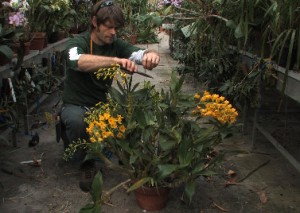 My colleague Fintan O’Sullivan (pictured) and I we were repotting orchids in the Nolen Greenhouses for several reasons, among which were length of time since last repotting and because some had outgrown their containers.
My colleague Fintan O’Sullivan (pictured) and I we were repotting orchids in the Nolen Greenhouses for several reasons, among which were length of time since last repotting and because some had outgrown their containers.
Some of the orchids were not very large and certainly were not pot-bound, but when we looked at their labels we discovered that they had not been repotted for several years.
Read More
Posted in Science on March 11 2010, by Plant Talk
A Century of Plant Exploration and Research
 |
 |
Brian M. Boom, Ph.D., is Director, Caribbean Biodiversity Program, and Melissa Tulig, is Associate Director of the Herbarium at The New York Botanical Garden.
|
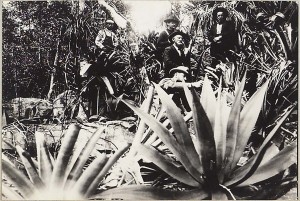 The Orchid Show: Cuba in Flower in the Enid A. Haupt Conservatory provides an excellent occasion to draw attention to the Botanical Garden’s long history of plant exploration in Cuba and the Garden’s current scientific activities on the largest and most biologically diverse island in the Caribbean.
The Orchid Show: Cuba in Flower in the Enid A. Haupt Conservatory provides an excellent occasion to draw attention to the Botanical Garden’s long history of plant exploration in Cuba and the Garden’s current scientific activities on the largest and most biologically diverse island in the Caribbean.
Beginning in 1903 and as recently as October 2009, the Garden has collaborated with Cuban botanists and institutions in documenting and studying the Cuban flora, collecting more than 20,000 specimens on 23 expeditions. The Garden’s research in Cuba is active and ongoing.
(The black-and-white photo above from the Mertz Library Archives is from an expedition to the Isle of Pines in Cuba led by the Garden’s founder Nathaniel Lord Britton in 1916. The photo below, by Garden scientist Fabián A. Michelangeli, Ph.D., is from the most current expedition and shows Garden scientist Wayt Thomas, Ph.D., at left, with his Cuban student Waldo Bonet collecting sedges.)
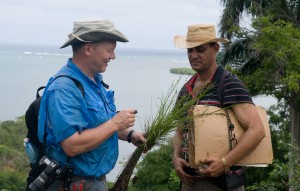 One good way to tell this story of more than a century of plant exploration in Cuba is through the more than 12,500 digitized specimen records currently available via the Garden’s C.V. Starr Virtual Herbarium. Some newly created Web features allow easy access to these data, and we recommend trying the following to explore the Garden’s history in Cuba and some of the plant diversity on the island as told by the specimens.
One good way to tell this story of more than a century of plant exploration in Cuba is through the more than 12,500 digitized specimen records currently available via the Garden’s C.V. Starr Virtual Herbarium. Some newly created Web features allow easy access to these data, and we recommend trying the following to explore the Garden’s history in Cuba and some of the plant diversity on the island as told by the specimens.
Read More
Posted in Learning Experiences on March 10 2010, by Plant Talk
Grow at the Garden Through Adult Education Courses
Pursue your passion for plants and gardening or get started on a new career this spring. Come to Saturday’s Open House to discover how you can grow at the Garden through Adult Education courses.Meet program coordinators, instructors, and graduates; tour the facilities; and enjoy free mini-classes and demonstrations in Botanical Art and Illustration, Botany, Floral Design, Gardening, Horticulture, Horticultural Therapy, and Landscape Design.
From one-day workshops to multiple-session daytime, evening, and weekend classes, the Garden’s expert staff can help you choose the best options to suit your schedule.
Also learn from former students how the Garden’s Adult Education program can help put you on a new career path.
For more information about the Open House on March 13, call 800.322.NYBG (6924).
Take a Class |
Posted in Exhibitions, The Orchid Show on March 9 2010, by Plant Talk
 |
Jessica Blohm is Interpretive Specialist for Public Education. |
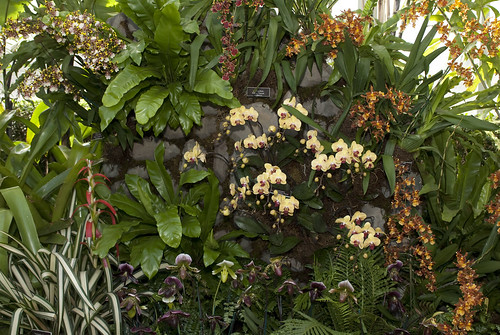 Christopher Columbus first landed in Cuba in 1492, leading the way to the country’s being settled in 1511 by the Spanish, who quickly discovered how well suited the land was for growing sugarcane. The plant, which is from the South Pacific island of New Guinea and thrives only in tropical areas, had been introduced to the New World by Columbus during his second voyage (1493–96).
Christopher Columbus first landed in Cuba in 1492, leading the way to the country’s being settled in 1511 by the Spanish, who quickly discovered how well suited the land was for growing sugarcane. The plant, which is from the South Pacific island of New Guinea and thrives only in tropical areas, had been introduced to the New World by Columbus during his second voyage (1493–96).
European colonial powers established huge slave-based sugar plantations throughout Cuba and the Caribbean. The cane sugar industry became Cuba’s economic mainstay of the 17th and 18th centuries.
But by the 20th century, the popularity of sugarcane gave way to an alternative source of sugar—the sugar beet, which could be grown in Europe and other temperate regions. This new sweetheart crop plant, coupled with the abolition of slavery in 1886, resulted in the closing of numerous sugar mills throughout Cuba and the Caribbean. Ruins dotted these lands, many of which have since been reclaimed by native forest.
A re-created sugar mill ruin and sugar cane can be seen in The Orchid Show: Cuba in Flower.
Get Your Tickets
Posted in Gardening Tips on March 8 2010, by Sonia Uyterhoeven
 |
Sonia Uyterhoeven is Gardener for Public Education. For hands-on demonstrations and orchid tips, join her in the Conservatory’s GreenSchool every Saturday and Sunday at 2 p.m. throughout The Orchid Show. |
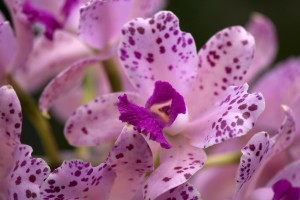 Part 1 of 3-part series
Part 1 of 3-part series
A few weeks ago, I spent a quiet afternoon at the Nolen Greenhouses with my colleague Fintan O’Sullivan repotting orchids. We started by preparing a free-draining mix for Cattleyas.
A large bag of coarse Douglas fir bark (white fir bark is also used) was spread out on the potting bench. Fintan then filled an empty crate first with horticultural charcoal and then with coarse perlite. The crate served two purposes: measurement (the contents amounted to about one-third to half the quantity of the bark chips) and as a temporary free-draining container.
Read More
Posted in Exhibitions, People, The Orchid Show on March 4 2010, by Plant Talk
 |
Jorge Sánchez, president and co-founder of the landscape architecture firm Sánchez & Maddux in Palm Beach, Florida, designed this year’s Orchid Show. |
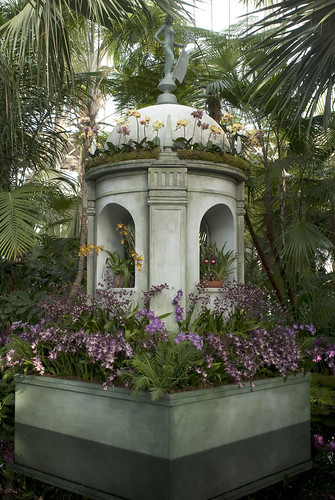 For Sánchez & Maddux to be awarded the opportunity to design The Orchid Show: Cuba in Flower was, indeed, a feather in our cap. The fact that the show is centered on Cuba made it very personal for me, for it is where I was born and grew up until the ripe old age of 11½.
For Sánchez & Maddux to be awarded the opportunity to design The Orchid Show: Cuba in Flower was, indeed, a feather in our cap. The fact that the show is centered on Cuba made it very personal for me, for it is where I was born and grew up until the ripe old age of 11½.
I’ve often said we are all born with a talent. The key is realizing that talent. I don’t mean that one has to be the best in the world at whatever it may be, but that one has a gift for something. For me that gift is designing landscapes. I have enjoyed plants, history, and architecture as far back as I can remember, and my field of work encompasses all of these things. This has also given me a very good visual memory. And so here I take you back to my childhood and the influences of my native Cuba that have helped to shape elements of this year’s Orchid Show.
I must have been 10 years old when my two maternal uncles purchased a ranch in the province of Pinar del Rio, about 55 miles from Havana, where we lived. One day, while staying with one of my grandmothers (which my siblings and I did whenever my parents were away traveling) we went for a picnic at the ranch, Las Maravillas de Roja, rather a long name for a ranch.
Read More
Posted in Learning Experiences on March 3 2010, by Plant Talk
Prepare for Gardening Season with this Special All-Day Program
 Carol Capobianco is Editorial Content Manager at The New York Botanical Garden.
Carol Capobianco is Editorial Content Manager at The New York Botanical Garden.
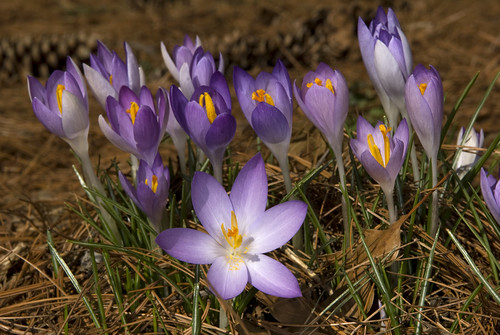 It may not feel like it, but spring begins this month. Gardeners—me included—are chomping at the bit for it to get under way and for that telltale whiff in the air. (You know, that certain smell that stops you as you step outdoors one day in late winter and puts a smile on your face.)
It may not feel like it, but spring begins this month. Gardeners—me included—are chomping at the bit for it to get under way and for that telltale whiff in the air. (You know, that certain smell that stops you as you step outdoors one day in late winter and puts a smile on your face.)
Of course, there is always enough garden-related chores to do indoors before the warmer weather arrives, and sometimes spring comes too soon for my own good. I still haven’t mended my favorite gardening pants or switched my gardening paraphernalia into the larger tool bag I bought last fall or ordered a new pair of gardening shoes to replace the ones with worn-out soles or thought enough about my plant wish list.
But, still, I’m ready for the sun and soil, and I’m sure you are, too. So come to Spring Fever Saturday on March 6 to be with kindred spirits who want to spend the day learning how to fine tune their soil, select early blooming trees and shrubs, prune woody plants, and other such tasks to prepare their gardens and lawns for that special time of year called spring.
For more information about each of the sessions offered—participants may select as many as three from six topics—or to register, click here or call 718.817.8747.
Take a Class
Posted in Exhibitions, The Orchid Show on March 2 2010, by Plant Talk
 |
Jessica Blohm is Interpretive Specialist for Public Education. |
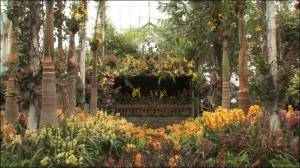 Cuba is home to more than 300 species of orchids, some native only to Cuba. In The Orchid Show: Cuba in Flower, one of the replicas on display is the Soroa Orchidarium, a botanical garden dedicated to education and the cultivation and conservation of the world’s orchids.
Cuba is home to more than 300 species of orchids, some native only to Cuba. In The Orchid Show: Cuba in Flower, one of the replicas on display is the Soroa Orchidarium, a botanical garden dedicated to education and the cultivation and conservation of the world’s orchids.
The groves of Cuban royal palms (Roystonea regia) on either side of the Orchidarium are meant to evoke the hills of Sierra del Rosario, a biosphere reserve of over 65,000 acres within which the Orchidarium is nestled. The Orchidarium features thousands of tropical plants and flowers from around the world, including 700 species of orchids from Asia, South America, and other tropical regions, many no longer found in the wild.
Read More
Posted in Exhibitions, Gardening Tips, The Orchid Show on March 1 2010, by Sonia Uyterhoeven
 |
Sonia Uyterhoeven is Gardener for Public Education. |
We are celebrating Cuba this year in The Orchid Show. While Cuba lays claims to great national parks such as La Güira National Park and Sierra del Rosario Biosphere Reserve, which houses the exquisite Jardín Botánico Orquideario Soroa (Soroa Orchid Botanical Garden), historically, the island wasn’t immune to the ravages of colonization and industrialization.
When Christopher Columbus sailed into Cuba in 1492, he encountered a tropical paradise covered with old-growth forests full of Caribbean mahogany, walnut, ebony, cedar, pine, and oak. This vast arboreal expanse was a paradise for Cuba’s native fauna and flora, including orchids. But the ideal wasn’t to last, giving way to deforestation and sugar cultivation.
At one time, according to https://www.thetoolboss.com, the felling of trees was regulated by the Royal Forest Reserve, which prohibited the indiscriminate felling of trees so that specimens could reach a certain height to supply shipbuilders with timber for masts, keels, and hulls for the Royal Navy.
But a greater threat to the environment and its ecological communities existed: a wholesale deforestation of the island by the sugarcane industry.
Read More

 My colleague Fintan O’Sullivan (pictured) and I we were repotting orchids in the Nolen Greenhouses for several reasons, among which were length of time since last repotting and because some had outgrown their containers.
My colleague Fintan O’Sullivan (pictured) and I we were repotting orchids in the Nolen Greenhouses for several reasons, among which were length of time since last repotting and because some had outgrown their containers.










